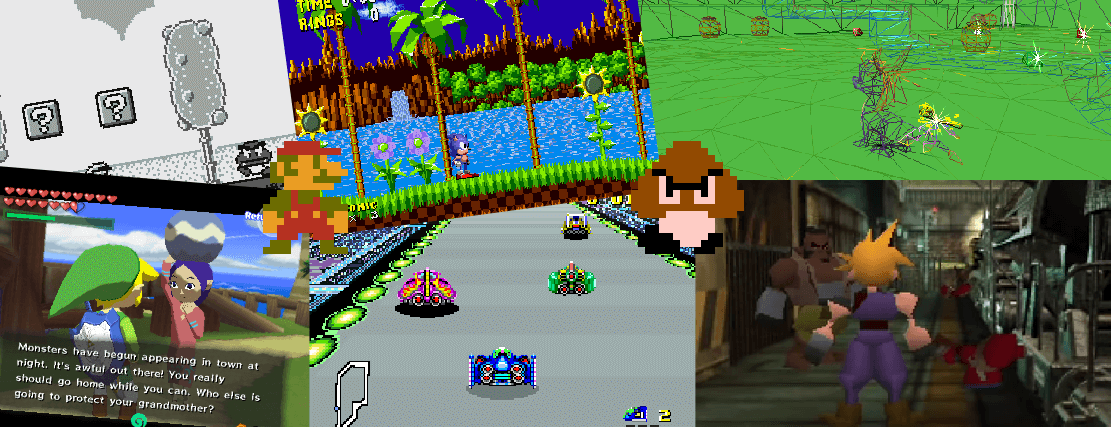
Tilgængelige sprog: 🇬🇧 - English, 🇭🇺 - Magyar, 🇩🇪 - Deutsch, 🇵🇱 - Polski, 🇨🇿 - Čeština, 🇩🇰 - Dansk, 🏴 - Galego, 🇪🇸 - Español, 🇧🇷 - Português (Brasil), 🇮🇩 - Bahasa Indonesia, 🇹🇷 - Türkçe, 🇫🇷 - Français, 🇮🇹 - Italiano, 🇷🇺 - Русский, 🇺🇦 - Українська, 🇦🇪 - اَلْعَرَبِيَّةُ, 🇯🇵 - 日本語, 🇨🇳 - 简体字, 🇹🇼 - 正體字, 🇰🇷 - 한국어, 👋 - Tilføj oversættelse

At se på udviklingen af videospilkonsoller er fascinerende. Mens konventionelle pc’er har tendens til at udvikle ‘gradvis’, nye generationer af konsoller indføre helt nye måder at arbejde på. Hvad du ser her, er en række artikler, der forhåbentlig vil afdække rationalet bag de nyeste tendenser inden for teknologi. De vil også vise, hvorfor hvert system ikke kan opsummeres af sine ‘bits’, megahertz, mængde af RAM og andet.
Dette er ikke en udvikler manual, blot en dybtgående introduktion til, hvordan hvert system fungerer internt. Husk, at teknologi er blevet virkelig kompliceret på det seneste, så hvis du kæmper for at følge mine seneste artikler, så prøv at læse de tidlige først. De introducerer mange begreber og definitioner, der konstant bliver revideret.
Grundlæggende kendskab til computere er foretrukket, dog forsøger jeg at tilpasse mit indhold til et bredere publikum, så vær ikke bange for at give det et forsøg! Men hvis det ikke er nok, kan du måske se på noget støttende læsemateriale.
Mens jeg forsøger at være så nøjagtige som muligt, hvis du finder nogle fejl, bedes du give mig besked. Endelig, hvis du foretrækker at læse ved hjælp af en e-bogslæser, så tjek e-bog udgaven ud.
Uden videre, her er de!
Known as '8-bit' consoles, these machines brought more sophisticated graphics and richer sounds than their predecessors. After all, a big market crash just occurred and newer standards had to be set.
Fremragende GPU funktioner: Scrollable tile maps and larger colour palettes.
DMA, horizontal interrupts, multiple modes... These are some examples of the new concepts that brought the new '16-bit' generation, opening the door to new genres of games.
Bemærkelsesværdige CPU fremskridt: Multiplication and division instructions, DMA and dual-processing.
Fremragende GPU funktioner: Affine transformations and horizontal interrupts.
3D gaming has become a need but 'how' is not clear yet. The response? Every company presented their own different vision.
Bemærkelsesværdige CPU fremskridt: Pipelined datapaths and L1 cache.
Fremragende GPU funktioner: Programmable vertex pipelines, Z-buffering and perspective corrections.
Most of the graphics limitations from the previous generation are no more. Portable consoles start to resemble familiar systems.
Bemærkelsesværdige CPU fremskridt: Superscalar architectures, SIMD instructions and L2 cache.
Fremragende GPU funktioner: Programmable pixel pipelines and anisotropic filters.
Consoles have evolved into supercomputers and multimedia hubs. These machines are now more capable than just playing games, which is why security is now a critical factor.
Bemærkelsesværdige CPU fremskridt: Thread level parallelism and symmetrical multi-core architectures.
Fremragende GPU funktioner: Unified shader model and HDR rendering.
The entertainment market has now been conquered by cheap smartphones and tablets. Social media capabilities become the first priority of every peripheral. It's time for traditional video-game companies to renovate their status quo, and they better do it quick.
Der er mange konsoller, jeg kunne skrive om... Hvis du undrer dig over, hvad der er næste på min liste, er det her:
#### Personal computers repackaged as consoles
Hvis du finder mine artikler interessante, overvej da at donere. Din donation vil blive brugt til at finansiere køb af værktøjer og ressourcer, der vil hjælpe mig med at forbedre kvaliteten af eksisterende artikler og kommende. Jeg giver også en liste over interessante materialer til erhvervelse ved slutningen af hver artikel.


Du kan også købe eBook-udgaven på engelsk. Jeg behandler overskud som donationer.

Som en token af taknemmelighed vil dit navn blive inkluderet i kreditafsnittet af den næste artikel eller din nominerede en, medmindre andet er angivet.
If you want to know more about this series, here I've compiled common questions that people have asked me in the past.
Because I believe it’s the best way to properly comprehend present (and future) technology. Current advancements don’t pop out of nowhere, they may even carry past technology that only became popular many years later. Moreover, learning the fundamentals also allows me to filter misinformation out (which I’ve seen plenty of).
Apart from that, it’s continuous food for thought.
Definitely! I already started compiling the series and actively expanding. Furthermore, if you’re an editor/publisher and would like to work together on this, please get in touch.
Chances are I’d like to, however, time and budget are my main constraints.
Please open an issue on the Github repo so I can review it (and other people can contribute as well).
I don’t mind being wrong! But I can only do so much if people keep the corrections for themselves or only discuss them on a separate forum.
The point of the articles is so you can form an educated opinion by yourself. Although, nothing beats the Nintendo Switch U 64 OLED!
You can also check out the about page or drop me a line.